Restoration Plan for The M/V Med Taipei ISO Container Discharge Incident
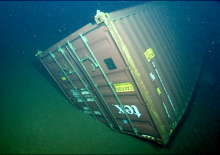 |
| This shipping container was discovered upside down on the seafloor by MBARI researchers in June 2004, four months after it was lost at sea. A joint expedition of MBNMS and MBARI research staff revisited this site in April 2011. Image: 2004 MBARI |
Monitoring the impact of lost container TGHU7712262 to deep seafloor habitat at Smooth Ridge
What Happens to Lost Containers?
According to the shipping industry, tens of thousands of intermodal containers have already been discharged into the world's ocean, and thousands are lost at sea every year. Container losses not only represent a tremendous waste of manufacturing effort, energy and money, but they also aggravate the impacts of marine debris as they take centuries to degrade, and in certain cases they may release hazardous and toxic materials into the environment.
Compensatory Restoration
Using funds from the legal settlement of $3.25 million between NOAA and the shipping company responsible for dropping 15 cargo containers while transiting through the sanctuary in 2004, the MBNMS is conducting a deep benthic assessment and monitoring of the site where container TGHU7712262 is located in 1,281 meters (4,203 feet) on Smooth Ridge, a submarine formation extending southwest from Monterey Bay, California. By monitoring the impact site a greater understanding of decomposition rates and potential impacts over time of steel containers and contents, as well as the recovery rates of natural habitats in the deep seafloor will be achieved. Since several hundred container ships transit through the MBNMS each year, the chances for additional container discharges, past and future, are very likely.
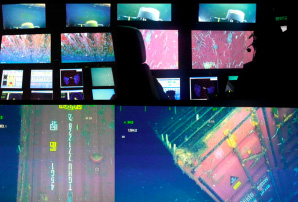 |
Shipping container TGHU7712262, seven years after it was lost at sea. In April 2011, a joint expedition of MBNMS and MBARI research staff revisited this site to assess the current condition of the lost container and the deep seafloor habitat around it. Images: 2004 MBARI, Chad King and Sacha Lozano (MBNMS) |
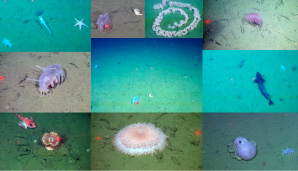 Deep seafloor species found further away from the lost container, representing the natural biological communities living on soft muddy sand flats at 4,000 ft depth, on Smooth Ridge. Images: Chad King and Sacha Lozano (MBNMS) Deep seafloor species found further away from the lost container, representing the natural biological communities living on soft muddy sand flats at 4,000 ft depth, on Smooth Ridge. Images: Chad King and Sacha Lozano (MBNMS) |
Potential impacts from this and other lost containers to deep-sea habitats and biological communities include:
- Crushing and smothering of organisms living on the bottom.
- Shifts in local ecology.
- Introduction of foreign habitat structure, which may attract and spread foreign species.
- An expanding human footprint on deep seafloor over time, as the containers degrade and collapse, spreading their contents along the ocean floor.
- Marine species entrapment and ingestion risks from released container contents.
- Deposition of plastics, other oil-based products, hazardous materials, and subsequent bioaccumulation.
Monitoring TGHU7712262 will allow MBNMS to assess and understand ongoing impacts, fate and effects of container deposition, inform restoration or mitigation efforts, and help shape future response policy and strategies to prevent deep-ocean habitat disturbance.
Lost Container Expedition
During March 8-10 2011, a team of scientists and educators from Monterey Bay National Marine Sanctuary (MBNMS) and Monterey Bay Aquarium Research Institute (MBARI) conducted a research expedition on board MBARI's research vessel Western Flyer, to investigate the current condition and potential ecological impacts of the lost container, TGHU7712262.
Despite the location of TGHU7712262 in 1,281 meters (4,203 feet), scientists were able to explore both the container and the deep seafloor around it, using a MBARI's remotely operated vehicle (ROV) Doc Ricketts. High-resolution photographs and video footage were taken along and biological and sediment samples were collected from the deep seafloor. Scientists were particularly interested in comparing the communities of sea life and the chemistry (carbon and nitrogen) of sediments found on and around the container, versus those on the seafloor at a distance from it.
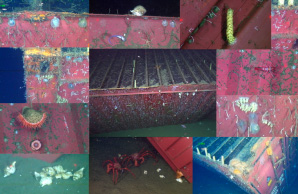 |
Biological community of deep-sea hard substratum species growing on shipping container TGHU7712262, at 4,203 feet of depth off Monterey Bay, seven years after it was lost at sea. Images: Chad King and Sacha Lozano (MBNMS) |
What Did Scientists Find?
The site was clearly impacted by the shipping container. The most obvious sign of impact was a clear difference in the composition of species found on and immediately adjacent to the container, versus further away. Common species on the container were the sea snail (Neptunea), scallops, and serpulid polychaete worms. Two large crabs were also present under a turned up corner of the container. The fauna on the container was not particularly different to other deep-sea hard substratum habitats investigated in Monterey Bay, but it is foreign to the biological communities living on the soft seafloor at Smooth Ridge. This is likely causing changes in food webs, access to space and resources, and ecological interactions, in a habitat that remains largely unexplored and is not yet understood. The container shows no major signs of wear after 7 years, and it will likely stay there for many hundreds of years. Common species away from the container were juvenile crabs (Lithodidae), sea pigs (Scotoplanes) and sea pens (Anthoptilum). The muddy sand seafloor at 4,000 feet was a beautiful smooth seascape with delicate worm tubes every few inches, abundant sea cucumbers, and red sea pens.
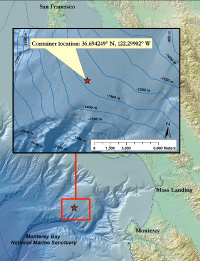 |
| Smooth Ridge, a submarine formation extending southwest from Monterey Bay, is the current location of cargo container TGHU7712262, lost at sea in 2004. Click here for larger detail. |
Scientists also collected sediment samples (at the container's location and further away) to compare the communities of species that live buried in the mud, and investigate the differences in chemistry (nitrogen and carbon). These analyses will provide more specific clues about the nature and extent of ecological changes taking place at the impact site.
The exploration of lost container TGHU7712262 is a study of one place, at one time. More research is required in order to confidently state the extent of the environmental impact derived from shipping container losses. With a vast majority of the deep sea is still unexplored, impacts to the deep sea may be occurring before a clear understanding of community composition and functions has been achieved.
Cruises to M/V Med Taipei Container
